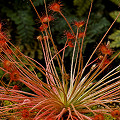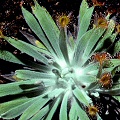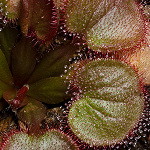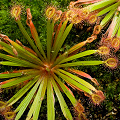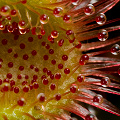Q: The "petiolaris-complex"
| The "petiolaris-complex"1 | |
|---|---|
|
D. banksii2 D. brevicornis D. broomensis D. caduca D. darwinensis D. derbyensis D. dilatato-petiolaris D. falconeri |
D. fulva D. kenneallyi D. lanata D. ordensis D. paradoxa D. petiolaris2 D. subtilis |
|
1All in Drosera sect. Lasiocephala; Australian. 2Also found in Papua New Guinea. |
|
A: This group of sundews consists of very
closely related rosetted species that live in very warm, seasonally moist areas. Since their habitat is
largely tropical, the seasonal variation seems to be more firmly dependent upon the wet-dry season than temperature
changes. All are restricted to Australia, unless otherwise noted.
Most of these plants look like a variation on the eponymous Drosera petiolaris, that is, a rosette of
plants with very long and narrow petioles, and comparatively small, round leaf blades that bear very sticky stalked glands.
In overall quality, the differences between the species are based upon characteristics such as how hairy the leaves are (some of the
plants--like Drosera ordensis--are really, really hairy), how large the plants are, or if the plants tend
to elongate in growth.
In the wild, these plants have been observed to hybridize, which complicates identifications.
Now, I must preface my following statements with a disclaimer: I have never seen these plants in the wild, and perhaps in the wild the
segregation of the plants into clearly defined populations is entirely obvious. However, I must say that some of the species in this
group seem very weakly separated from each other. I suspect that some field workers might easily interpret these species as merely
populations of a larger, more variable species. If you think I am wrong, please send me a check for US$2500 or so, so I can visit Australia
and make my own evaluations. Actually, double that because my wife will want to come along too. The same kinds of arguments can
be made about South African Drosera, too, so there is plenty of interestingg room for research in
this genus.
One species in this group, Drosera falconeri, really sticks out as an oddity. Unlike the
other plants in the petiolaris-complex, this plant has large leaf blades.
This plant looks like a sundew doing its best impersonation of a
Venus flytrap. It is quite bizarre. Despite these morphological characteristics, this plant can hybridize with the other
plants in the complex!
Growing these plants has mostly been a frustrating experience for me. In Arizona I grew them in a hot, extremely bright greenhouse and
did well with them. However, propagation was difficult. I was never successful with leaf cuttings, and was only able to vegetatively
propagate them by division when the plants naturally clumped. But even that was hard. Also, during the dry season the plants would
enter a dormancy during which I encurred significant losses. However, looking back at my efforts back then, I see some foolish mistakes
that I made. Many people are growing them now, so most of the cultivation secrets have been unlocked.
The easiest plants in this group to grow, in my experience, are Drosera paradoxa,
D. petiolaris, and D. ordensis. The hardest,
unfortunately, is Drosera falconeri. During dormancy these plants regress slightly to a
smaller rosette or, in some cases, something more like a hibernating bud. Drosera falconeri
can turn into a very tight bud that feels like a bulb. I recommend
growing them in a mix of peat:sand (1:1), or peat:aggregate (1:1) where the aggregate can be perlite, pumice, or gravel.
Unfortunately, and perhaps because of the difficulty in vegetative propagation, a large number of the plants in horticulture
(at least in the USA) are hybrids between the species. Since the species are often weakly separated already, such intermediate
(and fertile) hybrids are very difficult to figure out. However, they are vigorous in cultivation, so might make good plants for
a person trying to grow them for the first time. The rarity of pure species in cultivation is probably because most will not produce
seed if self-pollinated.
Vegetative propagation, at least of the less-hairy species, can be done via leaf pullings that are submerged in
purified water until they strike. This is a very cool technique!
Page citations: Lowrie, A. 1999, 2013;
Lowrie, A. et al. 2017a, 2017b; Rice, B.A. 2006a; personal observations;
Robinson, A. et al. 2017;
Schlauer, J. 1996, 2002.
